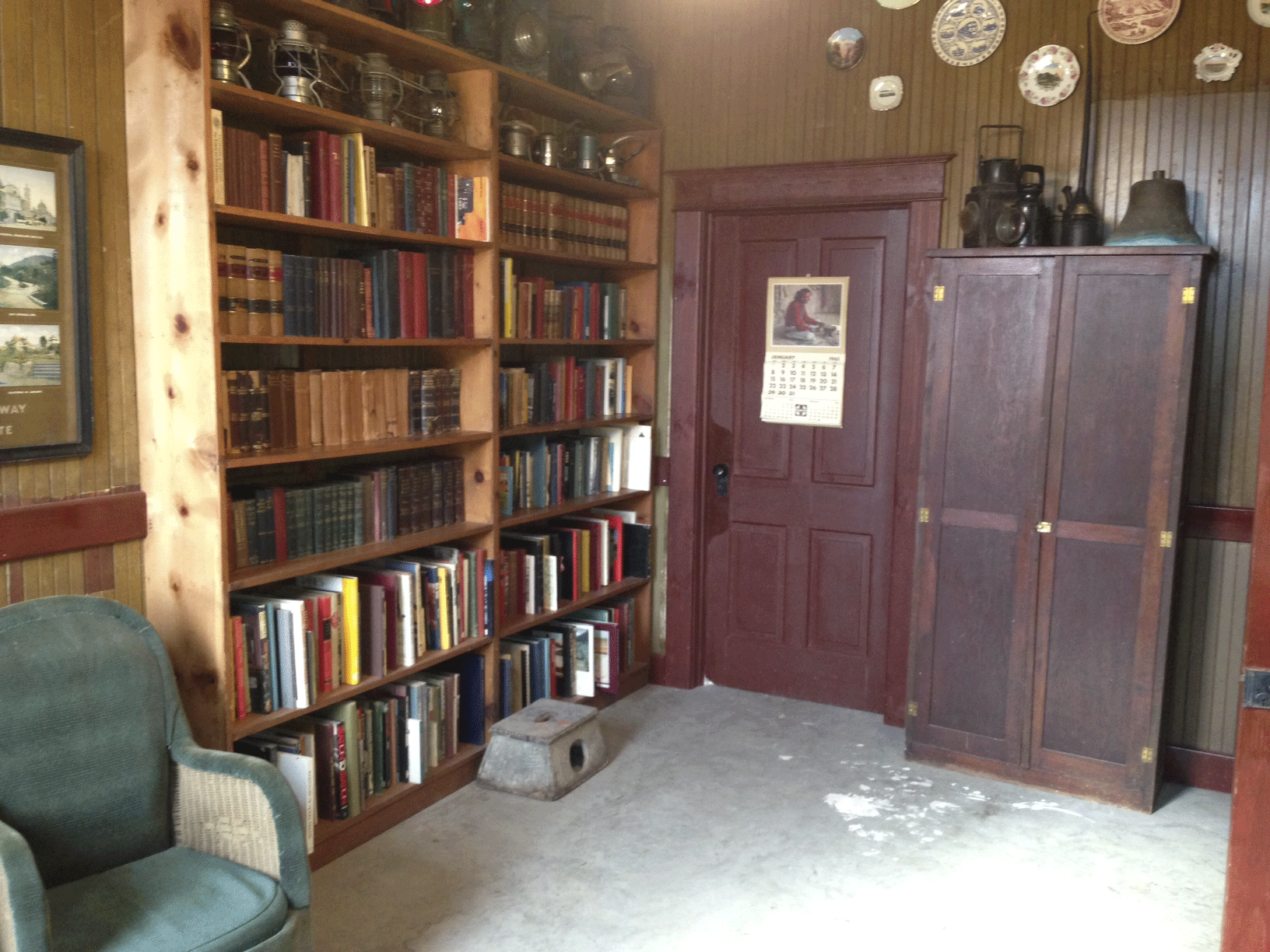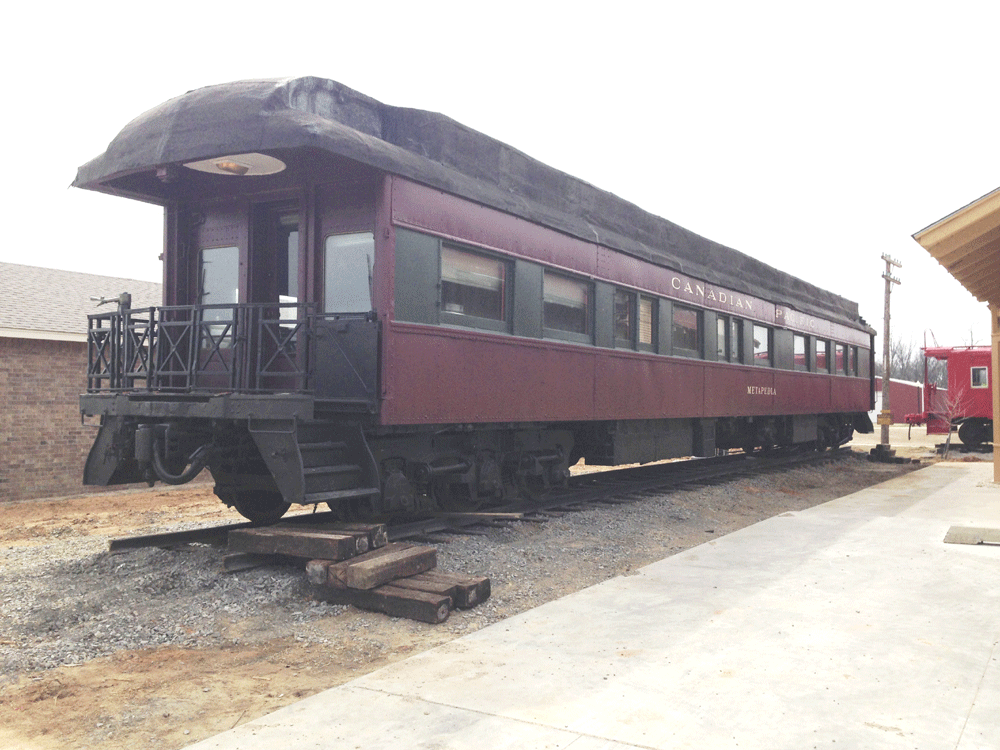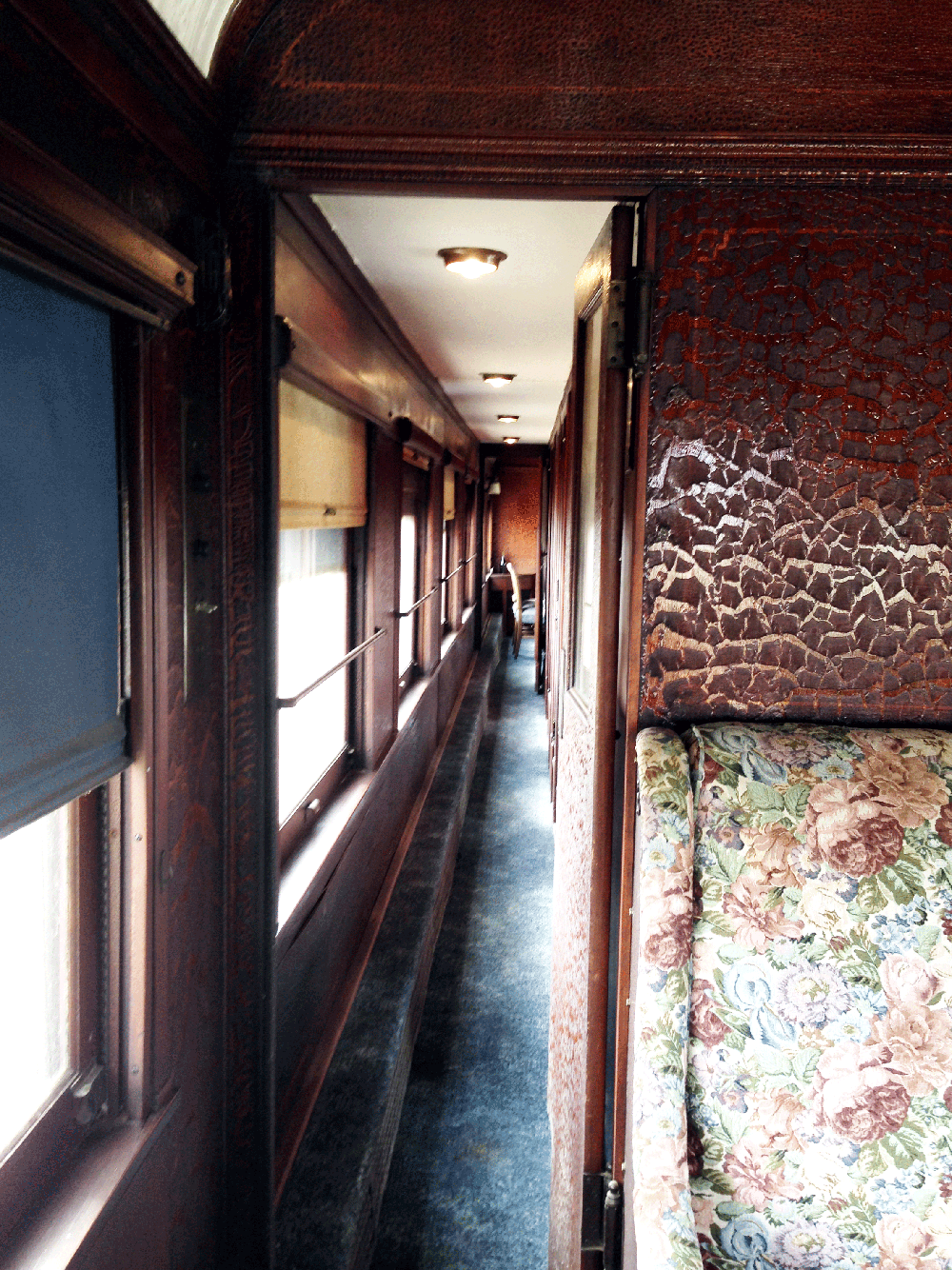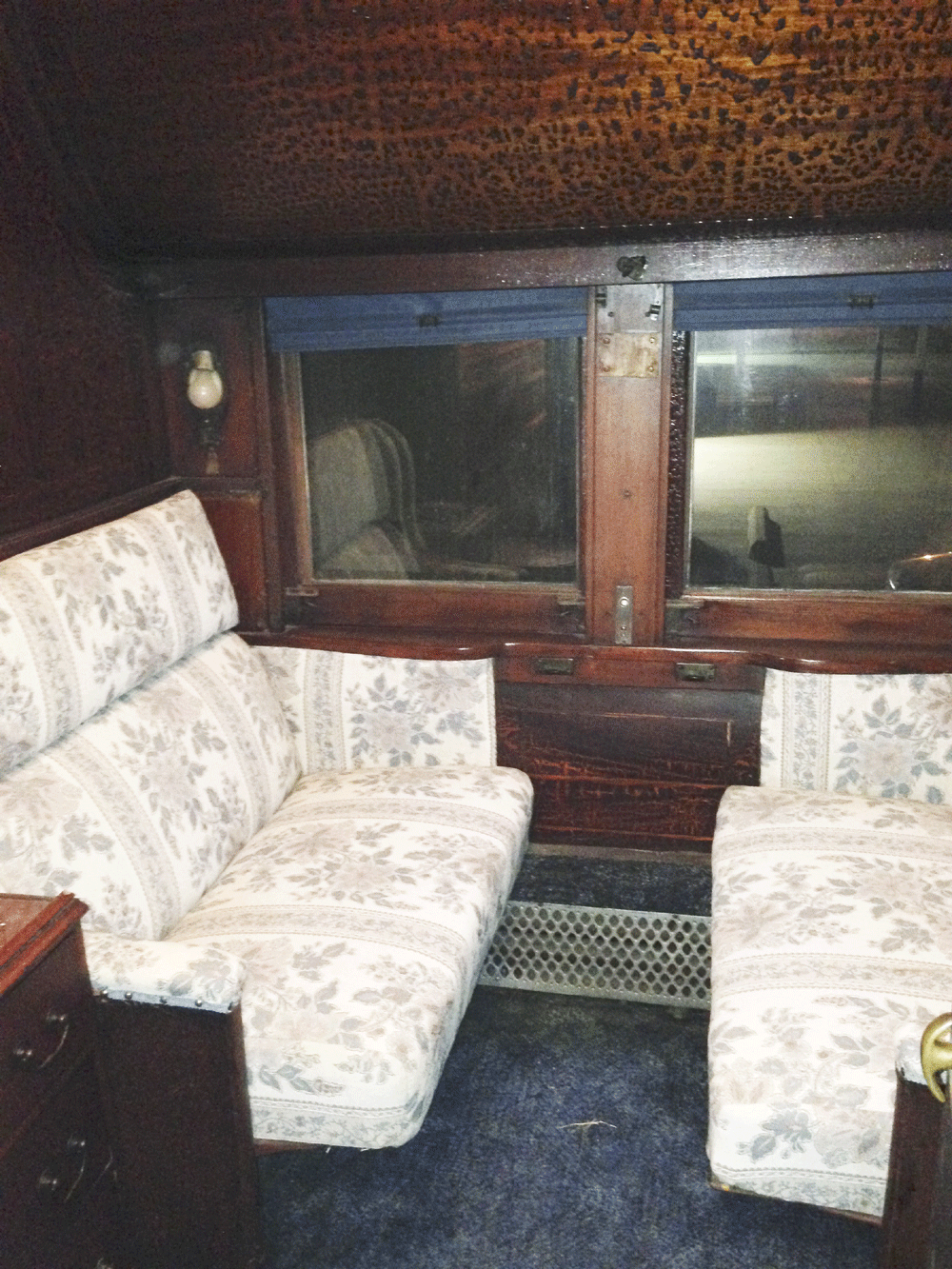Welcome Aboard!
The Cimarron Valley Railroad Museum was established by the Read family - Robert F. Read, Mazie Cox Read, and their son, Bob Read, Jr., in 1970 with the acquisition of the Santa Fe Depot from Yale, Oklahoma. Originally located in Cushing, Oklahoma, Robert F. Read donated the building and contents to the Oklahoma Territorial Plaza in 2011.
This particular depot was the site of E. H. Read's first agency from 1933-1936, following his many years of service at Cushing. Built in 1916, the depot was closed on April 19, 1968. The Read family felt it to be the place to house a large and growing collection of railroad memorabilia and had the building moved to Cushing in 1970.
The depot exhibits a great variety of railroad artifacts and rail memorabilia. There is a large collection of kerosene burning lanterns, uniform items, timetables, switch keys, locks, signal equipment, dining car china, silver settings, Fred Harvey items, a very extensive railroad library, bells, station signs, models, coach items, Pullman items, drinking glasses, badges, dining car chairs, linens, early day Santa Fe Transit, railroad advertising items, fire extinguishers, tools, furniture, stoves, official guides, and innumerable miscellaneous items of railroad heritage.
In 1974, the museum won an institutional award from the Oklahoma Heritage Association for its preservation of Oklahoma's Rail heritage and history.
The depot was restored through a gift by Cecil & Carol Acuff







Robert "Bob" Read in the depot, 2010

The "Metapedia" arriving in Lloydminster, Canada on Aug. 9, 1926, while it was still named the "Assiniboine."
The Canadian Pacific "Metapedia"
Built in
1903, by the Canadian Pacific Railroad (CPR) as a wooden dining car, this rail
car was converted to a high capacity parlor car in 1917. It was again transformed in 1919,
to a business coach at the CPR’s Angus Shops and was named the Assiniboine. It was assigned to D. C. Coleman, vice
president of the CPR’s western lines at Winnipeg. Coleman went on to become president of the Canadian Pacific
Railroad.
In the 1920’s, the car got a steel under frame and side sheathing and was renamed the Metapedia in 1929 when Coleman had a new “Assiniboine” coach built for his use. It was then assigned to the Atlantic region of the CPR.
In 1975, the Canadian Pacific Railroad retired the coach and it was purchased by Pierre Trudeau, the former prime minister of Canada, and his cousin, Guy Trudeau, who planned to use it as an office of a lumber company they owned.
Kenneth Mitchell of Guthrie purchased the railroad car in 1978 after seeing a listing in Trains Magazine and had it shipped by rail to Guthrie.
The Mitchell family donated the Metapedia to the Oklahoma Territorial Plaza in 2013.







The AT&SF caboose serves as the Perkins Park & Rec Office.
The caboose was a gift of Biff & Sue Horrocks.
Perkins Railroad History
From the time Perkins was founded, there were hopes and rumors of a railroad coming to town. It took ten years, but the railroad became a reality. The Eastern Oklahoma Railway Company was incorporated July 24, 1899, with capitol stock of $2,200,000. Directors were Aldace F. Walker, New York, New York; Edward P. Ripley and Edward B. Kenna, Chicago, Illinois; Frank T. Dolan, Wichita, Kansas; Henry E. Asp, U. C. Guss, and W. H. Merton, Guthrie, Oklahoma. The railroad started at Guthrie and ran east 73.5 miles to Pawnee, through the towns of Perkins, Ripley, Stillwater, and Glencoe. It was a part of the Atchison, Topeka, and Santa Fe system. The Perkins depot was located on the south bank of the Cimarron River, just southwest of the bridge.
The following account of the first train to Perkins was published in The Guthrie Leader, January 2, 1900: “The first passenger train over the Eastern Oklahoma railroad arrived in Perkins yesterday morning at 11 o’clock. All Perkins was out to meet the train and passengers. Yesterday was a day long to be remembered by Perkins citizens. The day with its events will be recorded and in after years will be history for the prosperous young city of Perkins, or the Queen City of Payne County. The people of Perkins are energetic. They wanted a railroad and they got it. At 8 o’clock yesterday morning, on invitation of Messrs. Coyle and Guss, right of way agents of the Oklahoma and Eastern railroad, the following Guthrieites met at the depot to make the trip to Perkins on the first train to that thriving city: Governor C. M. Barnes, Territorial Secretary Jenkins, J. W. McNeal, W. H. Merten, F. H. Greer, H. F. Ardery, J. W. Scothorn, John Golobie, Fred S. Barde, Otto Bekemyer, John Coyle, Paul McNeal, H. C. Phillips, engineer in charge of construction; J. F. NcNally, trainmaster; besides a number of passengers enroute to Perkins looking for a business opening. The train left Guthrie at 8:20, arriving at Perkins at 11 o’clock. The run was necessarily slow, as the track and roadbed were new. The road skirts the bluff all the away to Perkins, with the Cimarron River close on the opposite side of the road. The scenery is beautiful and in spring and summer the Eastern Oklahoma from Guthrie to Perkins can justly be called the scenic route of Oklahoma. The train was drawn by engine No. s7, in charge of Engineer Roache and Engineer Deegan. Conductor H. C. Watson, one of the most polite and accommodating railroad men in the Santa Fe service, looked after the safety and comfort of his passengers. Messrs. Sloan and Horton were the brakemen, who saw that each station was called in regular order. J. J. Harrop, foreman of the telegraph, was along in his official capacity. Mr. and Mrs. J. F. Croslin, of Guthrie, bought the first ticket from Guthrie to Perkins they will locate in the Queen city.
“After leaving Guthrie the first stop was made at Russell, eight miles out. Here Dr. G. N. White joined the party. He is from Missouri and was formerly located at Perkins. Miss Pearl Blair of Russell had the distinction of buying the first ticket sold from Russell to Perkins.
“You see that hump; that’s Campbell.” And when the train stopped G. W. Campbell boarded the train. Campbell is just 14 miles from the capital city. It already has twenty new buildings, eight of them being business houses.
“Iowa City (now Coyle) is a thriving burg, with about six business houses. It is 18 1/2 miles out. Here C. H. Lee and J. T. Owens joined the party of railroad and town builders. Mr. Lee is called the big man of Iowa City. He has a hardware and implement store second to none in Oklahoma. Mr. Owens is a general merchant and has a large stock goods.
“Goodnight is the last station before reaching Perkins. The passengers did not know that Goodnight existed until informed by the brakemen. If Goodnight does not soon take a jump into the commercial race the name will be changed to either Coyle or Guss.
“Arriving at Perkins the party was met by a delegation headed by the Perkins band, and escorted in carriages to the Hicks hotel, where everyone had a chance to test the quality of the last spike to be driven. This spike and several more spikes went home. The party was then escorted to the Christian church, where the following well arranged programme had been prepared:
Out of the woods. Saved by the Eastern Oklahoma Railroad.
Railroad souvenir program
New Year’s Day, 1900
Chairman of the day, Warren Chantry
Master of ceremonies, John P. Hickam
11 a.m. meeting of Gov. Barnes and guests
Music by the Perkins band
Driving of welcome spike
Carriage parade to hotel
Exercises in Christian church
Address of welcome, J. W. Garner
Music by the band
Response, Gov. Barnes
Music by the band
Address, Frank Greer
Address, Hon. W. A. Knipe
Address - “Back in the Old Days,” J. W. McNeal
Address, Secretary Jenkins
Address, W. H. Coyle
Address, U. C. Guss
Address, Rev. J. C. Owens
Presentation of check, Secretary Charles W. Kenworthy
And the tootin’ cars are here.
Perkins, Oklahoma, Jan. 1, 1900
DINNER - Hicks’ Hotel
“After being royally entertained the party returned to the train and the trip to Guthrie was made without delay. Everybody seemed to enjoy the day’s outing very much. Hon. Bill Knipe and Editor Hinkle came to Guthrie with the crowd. They could not resist the temptation to ride in the varnished cars.
“The following prospectors went to Perkins on the first train, they are looking for business locations: R. D. McKnight, Hunnewell; W. D. Martin and J. N. Hughes, Guthrie; John Douglass and Chas Carey, Oklahoma City; John Bingham and T. D. Heyle, McLoud; R. J. Rankin, representing a Chicago stove company, was the first drummer to make Perkins by way of the Eastern Oklahoma. L. M. Potts, who has resided in Guthrie for several years as cotton buyer for Berge Forbes & Co. of Sherman, was on the train for Perkins. Mr. Potts will stay there this season buying cotton.
“Besides the passenger traffic yesterday the freight business was something - one carload of flour was billed to Perkins from the Guthrie Milling Company.”
By June 30, 1900, the Perkins depot had shipped 24 carloads of cattle, 52 carloads of hogs, 17 carloads of cotton, 18 carloads of cotton seed, as well as several carloads of horses, hay, wheat, corn, and flour. In addition, it had received 10 carloads of flour, 8 carloads of coal, and 7 carloads of farm machinery and implements.
One of the legendary conductors of the railroad was John Fogarty, and Bill Burchardt wrote the following about him in an article that appeared in the Winter 1963 edition of Oklahoma Today, “John Fogarty was a Conductor for the Atchison, Topeka, and Santa Fe. His train was the old No. 410, but to the patrons along its circular run it was known as the ‘Four-hundred and Fogarty.’ It departed Guthrie at 5:00 p.m. every day, it ran eastward through Coyle, Perkins and Goodnight to Ripley, north through Stillwater, Glencoe and Pawnee to Skedee, then back south through Maramec and Yale to Cushing. Here it tied up for the night. The next morning it retraced this same circuitous route back to Guthrie.
“John Fogarty went to work for the Santa Fe in 1880 as a section hand. During the next fourteen years he was successively, an engine wiper, fireman, brakeman, then conductor. He took charge of No. 410 in 1905. It was his train for the rest of his life. The eighteen years of the Four Hundred and Fogarty were exciting years. Fogarty’s passengers were cowhands, roughnecks, tankies, and roustabouts of the oil boom towns. His passengers were also the men who made millions from oil; C. B. Shaffer, whose Wheeler No. 1 opened the Cushing Field in 1912; Tom Slick, the wildcatter whose income passed twenty million a year; E. W. Marland, who became governor of Oklahoma; Major Gordon ‘Pawnee Bill’ Lilly, and John Ringling of circus fame.
“Though it was not these, but little known folk whom time has forgotten, that made John Fogarty’s name legend. The family at the crossing near Glencoe for whom Mr. Fogarty always tossed an evening paper off the thundering train. The youngsters waiting there would give Mr. Fogarty a friendly wave, pick up the paper and run for home. For farmers along the route who lived a long way from station stops, Mr. Fogarty would stop the train anywhere out in the country, when there were few passengers on board, to let them off at the spot nearest to home. Mothers would put a child on the train saying ‘Please put my boy off at Guthrie, Mr. Fogarty,’ and go their way securely knowing that the lad would be safely watched. Old timers along the line met the train daily just to say ‘How d’ye do, Mr. Fogarty,’ and set their watches by the train’s punctual arrival.
“One afternoon four drunken cowpunchers boarded Fogarty’s train. They reeled through the aisle yelling and singing. Conductor Fogarty admonished them to sit and be quiet, that they were disturbing the other passengers. The train pulled out, but the conductor’s advise went unheeded. He returned to warn them that they must behave or get off. For an answer he got raucous laughter and a hooting demand as to ‘Who in the - - is going to put us off?’ Fogarty drew his pistol as he pulled the bell rope, and the train ground to a halt. ‘Get off and don’t lose any time,’ said Fogarty. Four chagrined punchers stared at the blue steel gun barrel, at the equally blue steel of Fogarty’s eyes, then got up and meekly marched off the train. They had been thrown off the iron horse, and a long way from town.
“The finest of tales of the Four Hundred and Fogarty came in the later years, when Mr. Fogarty was hospitalized. Word spread along the route that he might not return. It is unlikely that the whole history of railroading ever saw a day quite like the one on which John Fogarty returned to his run. Crowds were at the station, to meet the train at Coyle, Perkins, Maramec, Yale, Glencoe, and Cushing. Men pressed around to shake his hand. Women gave him flowers. People who couldn’t get close shouted greetings. The biggest crowd was at Stillwater, and there the town band was out. The train had to stand there for about fifteen minutes for transfer of baggage, mail and express. Throughout that time the band played and people made themselves hoarse yelling, ‘Hello, Mr. Fogarty! Glad you’re back.’ If the band stopped playing for a minute, somebody bellowed, ‘What’s the matter with Fogarty?’ and a chorus answered, ‘He’s all right!’ Women who couldn’t pass him their bouquets tossed them. Mr. Fogarty smiled in a stunned sort of way for a while and then he broke down and cried like a child. John Fogarty passed on to his reward July 23, 1923.”
John Bartholomew was another important figure in Perkins railroad history. He became station agent at Perkins in 1908 and held that position for 40 years, retiring in 1948. Prior to Perkins, he was agent at Kildare, Avery, and Goodnight. John, and his wife Mae, had one son William, who followed in his father’s footsteps becoming chief dispatcher of the Arkansas City depot. He and his wife Mona returned to Perkins after retiring.
From time to time there were accidents along the line. Two trains collided head-on one mile south of Ripley on May 22, 1908, killing a conductor and injuring one passenger. A special train carrying 250 students from Oklahoma A & M College to a track meet in Oklahoma City failed to stop in Ripley to allow a special railroad superintendents train to pass. The engineers and fireman jumped prior to impact preventing other deaths. In April 1909, heavy spring rains caused flooding along the tracks with all creeks and the Cimarron River running full bank. The morning train was taking the run especially slow, and as Engine No. 392 pulled onto bridge 27 west of Goodnight, the structure and engine sank into the creek. The crew escaped injury, but it took a wrecking crew from Newkirk several days to pull the engine from the water and right the tracks. On April 12, 1915, the train wrecked southeast of Perkins. The Perkins Journal wrote, “The derailment of seven tank cars of oil by the local, Monday, just east of the Cottingham switch, stopped traffic for one day and kept things ‘mussed up’ for some time. Five of the tanks bursted, the oil forming a small lake, which will later be recovered. The wreck has been the point of attraction for sight seers since it occurred, especially while the big wrecking crane was picking up the tanks and replacing them on the tracks.”
In 1956, Santa Fe requested that the Oklahoma Corporation Commission allow them to abandon the Eastern Oklahoma Railroad line due to lack of revenue. H. C. Willis, division superintendent, gave figures showing the line had lost money in 1954, 1955, and the first part of 1956. A delegation from Perkins consisting of J. A. McLauchlin, Jack Vassar, Everett Lawrence, Lee Kirk, Melvin Sager, Bob Evans, Delbert Butler, John Baker, and Joe Johnson, attended the Corporation Commission hearing protesting Santa Fe’s request, citing the serious condition caused by the drought the last three years. L. D. Abney, hearing judge for the Commission, put off a decision until the following year stating in his ruling, “ It is a serious situation for a community to lose its railroad station, and it is a serious situation for the railroad to operate while losing money.”
Floods in May 1958, washed out seven miles of track as well as the railroad bridge across the Cimarron River at Ripley, dooming the railroad to abandonment. Santa Fe filed an application with the Corporation Commission on August 13, 1958, to abandon and remove their track serving Perkins, Cushing, Coyle, Ripley, and Guthrie, due to the high cost of repair and replacement compared to the revenue and amount of business on the line. Perkins residents lost their fight to save the railroad and a glorious part of Perkins history came to an end.